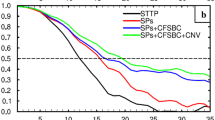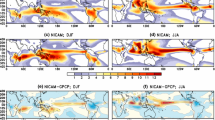Abstract
This study examines the forecast performance of tropical intraseasonal oscillation (ISO) in recent dynamical extended range forecast (DERF) experiments conducted with the National Centers for Environmental Prediction (NCEP) Global Forecasting System (GFS) model. The present study extends earlier work by comparing prediction skill of the northern winter ISO (Madden-Julian Oscillation) between the current and earlier experiments. Prediction skill for the northern summer ISO is also investigated. Since the boreal summer ISO exhibits northward propagation as well as eastward propagation along the equator, forecast skill for both components is computed. For the 5-year period from 1 January, 1998 through 31 December, 2002, 30-day forecasts were made once a day. Compared to the previous DERF experiment, the current model has shown some improvements in forecasting the ISO during winter season so that the skillful forecasts (anomaly correlation>0.6) for upper-level zonal wind anomaly extend from the previous shorter-than 5 days out to 7 days lead-time. A similar level of skill is seen for both northward and eastward propagation components during the summer season as in the winter case. Results also show that forecasts from extreme initial states are more skillful than those from null phases for both seasons, extending the skillful range by 3–6 days. For strong ISO convection phases, the GFS model performs better during the summer season than during the winter season. In summer forecasts, large-scale circulation and convection anomalies exhibit northward propagation during the peak phase. In contrast, the GFS model still has difficulties in sustaining ISO variability during the northern winter as in the previous DERF run. That is, the forecast does not maintain the observed eastward propagating signals associated with large-scale circulation; rather the forecast anomalies appear to be stationary at their initial location and decay with time. The NCEP Coupled Forecast System produces daily operational forecasts and its predication skill of the MJO will be reported in the future.




















Similar content being viewed by others
References
Annamalai H, Slingo JM (2001) Active/break cycles: diagnosis of the intraseasonal variability of the Asian summer monsoon. Clim Dyn 18:85–102
Chen T-C, Alpert JC (1990) Systematic errors in the annual and intraseasonal variations of the planetary-scale divergence circulation in NMC medium-range forecasts. J Atmos Sci 118:2607–2623
Chou MD, Lee KT (1996) Parameterizations for the absorption of solar radiation by water vapor and ozone. J Atmos Sci 53:1203–1208
van den Dool HM, Saha S (2005) Analysis of propagating modes in the tropics in short AMIP runs. WMO to appear
van den Dool HM, Toth Z (1991) Why do forecasts for “near normal” often fail? Weather and forecasting 6:76–85
Fels SB, Schwarzkopf MD (1975) The simplified exchange approximation: a new method for radiative transfer calculations. J Atmos Sci 32:1475–1488
Ferranti L, Palmer TN, Molteni F, Klinker E (1990) Tropical-extratropical interaction associated with the 30–60 day oscillation and its impact on medium and extended range prediction. J Atmos Sci 47:2177–2199
Flatau M, Flatau PJ, Phoebus P, Niiler PP (1997) The feedback between equatorial convection and local radiative and evaporative processes: the implications for intraseasonal oscillations. J Atmos Sci 54:2373–2386
Fu X, Wang B (2004) The boreal-summer intraseasonal oscillations simulated in a hybrid coupled atmosphere-ocean model. Mon Weather Rev 132:2628–2649
Hendon HH, Salby ML (1994) The life cycle of the Madden-Julian oscillation. J Atmos Sci 51:2225–2237
Hendon HH, Salby ML (1996) Planetary-scale circulations forced by intraseasonal variations of observed convection. J Atmos Sci 51:2225–2237
Hendon HH, Liebmann B, Newmann M, Glick JD, Schemm JE (2000) Medium-range forecast errors associated with active episodes of the Madden-Julian oscillation. Mon Weather Rev 128:69–86
Higgins RW, Schubert SD (1996) Simulations of persistent North Pacific circulation anomalies and interhemispheric teleconnections. J Atmos Sci 53:188–207
Hsu H-H, Weng C-H (2001) Northwestward propagation of the intraseasonal oscillation in the Western North Pacific during the boreal summer: structure and mechanism. J Clim 14:3834–3850
Inness PM, Slingo JM, Guilyardi E, Cole J (2003) Simulation of the Madden-Julian oscillation in a coupled general circulation model. Part II: the role of the basic state. J Clim 16:365–382
Jones C (2000) Occurrence of extreme precipitation events in California and relationships with the Madden-Julian oscillation. J Clim 13:3576–3587
Jones C, Waliser DE, Schemm J-KE, Lau WKM (2000) Prediction skill of the Madden-Julian oscillation in dynamical extended range forecasts. Clim Dyn 16:273–289
Jones C, Carvalho LMV, Higgins RW, Waliser DE, Schemm J-KE (2004a) Climatology of tropical intraseasonal convective anomalies: 1979–2002. J Clim 17:523–539
Jones C, Carvalho LMV, Higgins RW, Waliser DE, Schemm J-KE (2004b) A statistical forecast model of tropical intraseasonal convective anomalies. J Clim 17:2078–2095
Kalnay E and co-authors (1996) The NCEP/NCAR 40-year reanalysis project. Bull Am Meteorol Soc 77:437–471
Kemball-Cook S, Wang B (2001) Equatorial waves and air-sea interaction in the boreal summer intraseasonal oscillation. J Clim 14:2923–2942
Kemball-Cook S, Wang B, Fu Z (2002) Simulation of the ISO in the ECHAM4 model: the impact of coupling with an ocean model. J Atmos Sci 59:1433–1453
Krishnamurti TN, Subrahmanyam D (1982) The 30–50 day mode at 850 mb during MONEX. J Atmos Sci 39:2088–2095
Krishnamurti TN, Oosterhof DK, Metha AV (1988) Air-sea interaction on the timescale of 30–50 days. J Atmos Sci 45:1304–1322
Krishnan R, Zhang C, Sugi M (2000) Dynamics of breaks in the Indian summer monsoon. J Atmos Sci 57:1354–1372
Lacis AA, Hansen JE (1974) A parameterization for the absorption of solar radiation in the Earth’s atmosphere. J Atmos Sci 57:118–133
Lau K-M, Chan PH (1986a) Aspects of the 40–50 day oscillation during the northern summer as inferred from the outgoing longwave radiation. Mon Weather Rev 14:1354–1367
Lau K-M, FC Chang (1992) Tropical intraseasonal oscillation and its prediction by the NMC operational model. J Clim 5:1365–1378
Lau K-M, Phillips TJ (1986b) Coherent fluctuations of extratropical geopotential height and tropical convection in intraseasonal time scales. J Atmos Sci 43:1164–1181
Lawrence DM, Webster PJ (2001) Interannual variations of the intraseasonal oscillation in the South Asian summer monsoon region. J Clim 14:2910–2922
Liebmann B, Hartmann DL (1984) An observational study of tropical midlatitude interaction on intraseasonal time scales during winter. J Atmos Sci 41:3333–3350
Liebmann B, Smith CA (1996) Description of a complete (interpolated) OLR dataset. Bull Am Meteorol Soc 77:1275–1277
Lo F, Hendon HH (2000) Empirical extended-range prediction of the Madden-Julian oscillation. Mon Weather Rev 128:2528–2543
Madden RA, Julian PR (1994) Observations of the 40–50-day tropical oscillation – a review. Mon Weather Rev 122:814–837
Maloney ED, Hartmann DL (2000) Modulation of eastern north Pacific hurricanes by Madden-Julian oscillation. J Clim 13:1451–1460
Maloney ED, Kiehl JT (2002) MJO-related SST variations over the tropical eastern Pacific during Northern Hemisphere summer. J Clim 15:675–689
Matthews AJ (2000) Propagation mechanisms for Madden-Julian oscillation. QJR Meteorol Soc 126:2637–2651
McPhaden MJ (1999) Genesis and evolution of the 1997–98 El Niño. Science 283:950–954
McPhaden MJ (2004) Evolution of the 2002/03 El Niño. Bull Am Meteorol Soc 85:677–695
Mo KC, Higgins RW (1998) Tropical influences on California precipitation. J Clim 11:412–430
Murakami M (1979) Large-scale aspects of deep convective activity over the GATE area. Mon Weather Rev 107:994–1013
Schemm J-KE, van den Dool H, Saha S (1996) A multi-year DERF experiment at NCEP. 11th Conference on numerical weather prediction, August 19–23, 1996, Norfolk, Virginia, pp 47–49
Seo K-H, Kim K-Y (2003) Propagation and initiation mechanisms of the Madden-Julian oscillation. J Geophys Res 108(D13), 4384, doi:10.1029/2002JD002876
Seo K-H, Xue Y (2005) MJO-related oceanic Kelvin waves and the ENSO cycle: a study with the NCEP global ocean data assimilation system. Geophys Res Lett 32, L07712, doi:10.1029/2005GL022511
Sikka DR, Gadgil S (1980) On the maximum cloud zone and the ITCZ over Indian longitudes during the south west monsoon. Mon Weather Rev 108:1840–1853
Slingo JM, Powell DP, Sperber KR, Nortley F (1999) On the predictability of the interannual behaviour of the Madden-Julian oscillation and its relationship with El Niño. QJR Meteorol Soc 125:583–609
Sperber KR (2003) Propagation and veritical structure of the Madden-Julian oscillation. Mon Weather Rev 131:3018–3037
Sperber KR, Slingo JM, Inness PM, Lau K-M (1997) On the maintenance and initiation of the intraseasonal oscillation in the NCEP/NCAR reanalysis and in the GLA and UKMO AMIP simulations. Clim Dyn 13:769–795
Waliser DE, Jones C, Schemm J-KE, Graham NE (1999a) A statistical extended-range tropical forecast model based on the slow evolution of the Madden-Julian oscillation. J Clim 12:1918–1939
Waliser DE, Lau K-M, Kim J-H (1999b) The influence of coupled sea surface temperatures on the Madden-Julian oscillation: a model perturbation experiment. J Atmos Sci 56:333–358
Waliser DE, Lau K-M, Stern W, Jones C (2003a) Potential predictability of the Madden-Julian oscillation. Bull Am Meteorol Soc 84:33–50
Waliser DE, Stern W, Schubert S, Lau K-M (2003b) Dynamic predictability of intraseasonal variability associated with the Asian summer monsoon. QJR Meteorol Soc 129:2897–2925
Waliser DE, Schubert SD, Kumar A, Weickmann KL, Dole R (2003c) Modeling, simulation, and forecasting of subseasonal variability. Technical report series on global modeling and data assimilation, NASA/CP-2003–104606, 25, p 65
Wang B, **e X (1997) A model for the boreal summer intraseasonal oscillation. J Atmos Sci 54:72–86
Wang W, Saha S, Pan H-L (2004) Simulation and prediction of the MJO with the NCEP models. In: Proceedings of CMWF/CLIVAR workshop on simulation and prediction of intra-seasonal variability with emphasis on the MJO, Reading, United Kingdom, pp 237–249
Weickmann KM (1983) Intraseasonal circulation and outgoing longwave radiation modes during Northern Hemisphere winter. Mon Weather Rev 111:1838–1858
Woolnough SJ, Slingo JM, Hoskins BJ (2000) The relationship between convection and sea surface temperature on intraseasonal timescales. J Clim 13:2086–2104
Yansunari T (1979) Cloudiness fluctuations associated with the Northern Hemisphere monsoon. J Meteorol Soc Jpn 58:225–229
Zeng Y, Waliser DE, Stern WE, Jones C (2004) The role of coupled sea surface temperatures in the simulation of the tropical intraseasonal oscillation. J Clim 17:4109–4134
Acknowledgements
We would like to thank Drs. Huug van den Dool and Wanqiu Wang for their valuable comments and suggestions. We would also like to thank Drs. Ken Sperber and Duane Waliser for their careful reviews and constructive comments, which improved the manuscript. We are also grateful to Dr. Edwin Schneider for his kind proofreading. C. Jones was supported by a National Science Foundation grant (ATM-0094387).
Author information
Authors and Affiliations
Corresponding author
Rights and permissions
About this article
Cite this article
Seo, K.H., Schemm, J.K.E., Jones, C. et al. Forecast skill of the tropical intraseasonal oscillation in the NCEP GFS dynamical extended range forecasts. Clim Dyn 25, 265–284 (2005). https://doi.org/10.1007/s00382-005-0035-2
Received:
Accepted:
Published:
Issue Date:
DOI: https://doi.org/10.1007/s00382-005-0035-2




